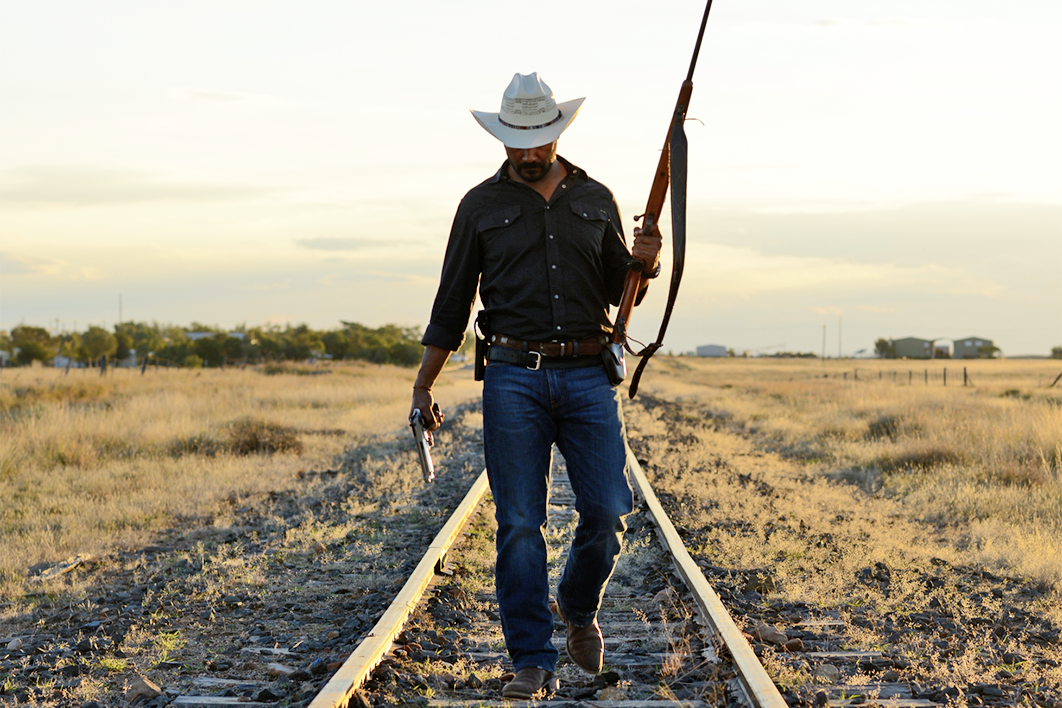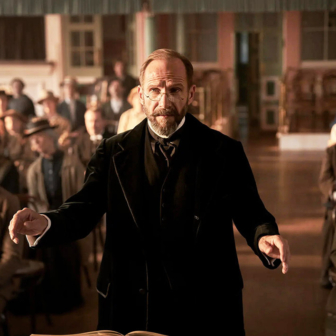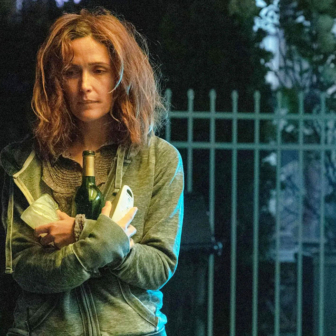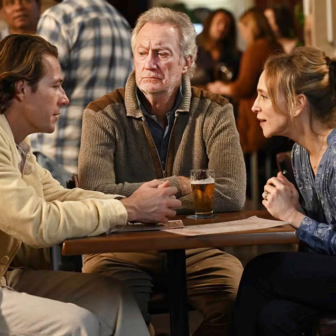Ivan Sen’s Mystery Road is a Western which observes the conventions of its genre: conflict of law and lawlessness in a remote setting; visible wide landscapes; a central character, the man who rides into town with a mission, a man who holds experience and emotion in reserve; a climactic shoot-out; laconic dialogue all round. Seen from behind, Aaron Pedersen’s Jay Swan has a John Wayne kind of walk; and this film, like many Westerns, looks outward across a realm of historical loss.
But it’s not about the domains of pioneers and frontiersmen, we’re not in Monument Valley, and the lawman isn’t on horseback. Horses do appear, but as the prized possessions of David Field’s wonderfully poisonous Sam Bailey, one of the story’s thriving villains. The detective drives an unpretentious sedan. The music is significantly unheroic: a few barely noticeable passages of long-held electronic lament in low and higher registers. Like the cinematography and editing, the music is Sen’s own; there is a sound-design credit, well deserved, to Lawrence Horne.
You notice the music only if, on a second viewing, you’re deliberately alert for it. In those sounds, however, the sadness is unequivocal. Detective Swan has returned after ten years to the small town of the film’s main action. He and the film are silent on his past in “the city,” a place which, like the town we’re in, goes unnamed. In his unfolding relations with his fellow-policemen and the locals, “the city” works as the absent source of his superior authority and skill, and also as the reason why he must be thwarted, choked-off whenever possible, taken down a peg.
At the place of the first murder, he asks the local sergeant (superbly performed by a wry Tony Barry) why the area hasn’t been roped off as a crime scene; the answer, a rebuff, is that this kind of thing just happens around here, no big deal. This victim, like the next one, is a black girl, and the question hangs: how different would the response have been if she’d been white? The town is mostly an Aboriginal community, and Jay Swan’s Aboriginality is at the psychological centre of the story. If there’s going to be any sort of an investigation, he’s an essential presence; at the same time, his status makes him a traitor among his own kind, since he’s going to subject them to the white man’s law. The word coconut isn’t used, but the accusation is actively in play.
Another charge hits him harder; he has failed to be a father to his daughter Crystal, who understandably doesn’t want to talk to him; nor do her friends, and Crystal’s mother Mary gives him no quarter when he tries for a conciliatory meeting. Sticking implacably to her routine, beer and the pokies, she tells him that she at least knows who she is. They all know more than they’ll tell him about the drug circuits, and about the girls who, it is said, “go with” the truckies for their supplies. Among the police, Hugo Weaving’s Johnno taunts him; Johnno, self-described as “a sad case,” is always one jump ahead with the dealers and informers; he is inveigling, mocking, complex, and a part of him would like Jay to get the case together. Weaving could be a great Hamlet, indeed an Iago.
As Crystal and Mary, young Tricia Whitton and Tasma Walton give performances of equal subtlety. Aaron Pedersen finely negotiates Swan’s double aspect, the wordless personal unease beneath the intent professionalism on the job. His character too is generic; the mean streets of the classic detective tale become these long, forking dusty roads and the grid of the town, seen in aerial shots as his car makes purposeful turns in pursuit – of just what, we’re kept unsure. As a Western, this is also a thriller; from the dark opening on the road, with the long track along the culvert underneath, the tension is extreme.
The uncertainties, the silences and broken-off exchanges, the crazy set-pieces in which Jack Thompson does dementia and Jack Charles does the scheming old know-all, all compose a world in which nothing’s going to be wrapped up. There will be the ominous passage with the roo-shooters, intimations of evil right out of Boorman’s Deliverance. There will be moments of lightness, even of promise, with the kids playing in the dust, and in the comedy of Swan’s strung-out negotiation with the boy who found a lost mobile phone. There will be the second murder, while the great rigs, the Titans of the outback world, go thundering along the highway; the speed and noise are relentless. Here, as in Beneath Clouds, the roaring juggernauts signal the forces against which the people of this town – any town – can do so little. As they loom up, drug dependence, petty trafficking and beer-soaked idleness make a terrible kind of sense; this account doesn’t even let in the struggling schoolteacher whose kind we saw last year in Sen’s Toomelah.
In that film, too, a small town has its place on the drug trails, a network criss-crossing outback Australia; Ivan Sen is giving us parts of a map we would rather not recognise as our own. It has been said that within every strong feature film there’s a documentary, the whole film’s grip on the world, and it’s true of Mystery Road. Some commentators have found it lacking for leaving those loose ends, the open gaps in Swan’s and the audience’s knowledge. If you pay close attention to the final quarter of an hour, there aren’t in fact so many gaps; but in any case, the kind of detective work that wraps the case up completely, with all the ends tied off, belongs with Agatha Christie and Poirot.
Tight plots can be part of cinema, but the richest and most interesting cinema makes doubt and silence visible; Ivan Sen has acknowledged the influence of Andrei Tarkovsky. (Those who want to see what he means should head for Brisbane immediately; all Tarkovsky’s films are playing in that city’s international film festival, until 24 November.)
The town in Mystery Road, not far from Massacre Creek and Slaughter Hill, belongs in Australian history, past and present. It inherits – and with the two murders indeed continues – what Henry Reynolds has recently named as “the forgotten war” between black and white, and the destruction of Aboriginal society over two centuries. The banal desolation of the town, with its untended yards, littered interiors and boredom, is wreckage from exactly that war. Some will say that this response calls into the film too much that lies outside it; but it’s exactly the inconclusiveness, the supposedly unanswered questions, that hold the story open on to history: consider those huge skies. This film is a small masterpiece. •





